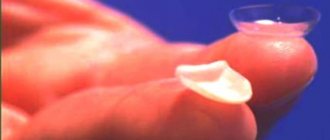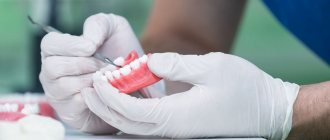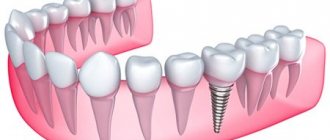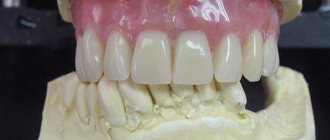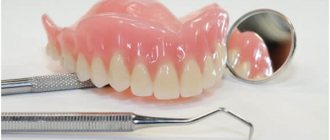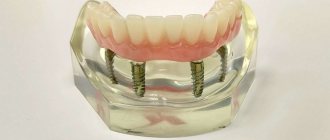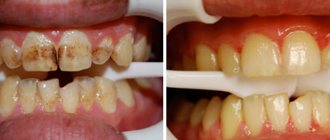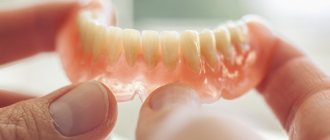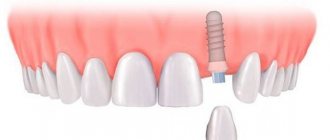As is known, with complete edentia, restoration of the dentition is carried out not by a single implantation of each tooth, but with the help of an orthopedic design supported by several implants. To fix the implants to each other and install the prosthesis on them, a beam fastening system is used. Structures with this type of fixation are usually called a beam prosthesis. What is a beam prosthesis on implants and what are its main advantages and disadvantages, says Omerelli Emir Romanovich, maxillofacial surgeon at the ROOTT dental center.
Bar denture
As is easy to understand from the name, the basis of this prosthesis is a beam - a structural element that takes on a vertical load. In implantology, this is the chewing load that is transferred from the jaw to the prosthesis and to the installed dental implants. In order for the pressure on the implants to be distributed evenly, they are all connected by a horizontal beam, on which there are places for attaching the orthopedic structure. For this purpose, special recesses are made in the prosthesis itself, through which the prosthesis is attached to the implants with special screws. Thus, the beam-fixed prosthesis becomes repairable, since if necessary, it can be removed (by unscrewing the screws), repaired and put back in place. Such a prosthesis allows you to restore several missing teeth or the entire dentition on one of the jaws.
Note!!!
It is believed that the bar prosthesis is conditionally removable, but it is necessary to remove the structure from the oral cavity quite rarely: this is usually done when it is necessary to clean the prosthesis, replace it, or repair it.
Review of new generation dentures without palate
Dentures without a palate are distinguished by materials of manufacture and design. According to the first sign, they distinguish:
- acrylic;
- nylon;
- soft - made of polyurethane.
Based on the design features, these new generation dentures without a palate : clasp dentures, sandwich dentures and Quadrotti dentures (Quattro Ti). When choosing a specific type of removable dentures without a palate, you need to consider the following nuances:
- number of lost teeth;
- the jaw on which the product will be installed (upper or lower);
- functionality of the area where prosthetics will be performed;
- choice of removable or non-removable type;
- dental and oral health status;
- financial capabilities of the patient.
Despite the wide variety of prosthetic designs, the choice of prosthesis should be made exclusively by the attending physician. Only a dentist can select suitable dentures without a palate that will not cause discomfort.
The cost of dentures without a palate depends on the materials used and the number of molars to be replaced. For example, a partially removable nylon denture, installed instead of 3 teeth, costs from 15,000 rubles. Nylon structures will cost approximately 35,000 rubles, and a full removable one will cost from 44,000 rubles.
How to care for a palateless prosthesis?
New generation palateless dentures can serve patients for a long time. But to increase the service life, you need to properly perform oral hygiene. Generally accepted recommendations:
- after each meal, the denture should be washed with warm boiled water;
- the structure must be periodically cleaned in an antiseptic solution;
- twice a day you need to carry out hygiene procedures with a regular toothbrush and toothpaste without abrasive particles;
- The product must be taken to the clinic for professional cleaning every six months.
If you adhere to the above rules, a removable denture without a palate can last from 10 to 15 years.
Manufacturing of a beam prosthesis on implants
Stage 1 – identifying contraindications
Before placing a bar-type prosthesis, the doctor must make sure that the patient has no contraindications to implantation. If there are factors that do not allow implantation, bar-fixed prostheses are replaced with classical prosthetics, which can be performed in this clinical case.
These factors include:
- serious problems with blood clotting;
- severe cardiovascular diseases;
- significant endocrine disorders;
- cancerous tumors.
Cases of significant atrophy of bone tissue and inflammation in the oral cavity are considered separately. Most often, these problems can be solved, after which implantation can be performed. As for allergic reactions to the metal of the beam, it is now made from titanium alloys, which are hypoallergenic.
Stage 2 – implantation of titanium roots
Bar dentures are used in cases of complete absence of teeth. Before installing the orthopedic structure, a surgical stage is carried out: installation of the required number of implants; a bar dental prosthesis can be attached to four implants, but depending on the specific clinical case, their number can increase to 6 or even 10 pieces. In any case, to install a removable bar denture on implants, you must have at least three artificial roots, otherwise the structure will not be able to be fixed properly. If we are talking about replacing several teeth in a row, then classical prosthetics on implants is usually used.
Stage 3 – production of a beam prosthesis
After installing the implants, impressions are immediately taken and preparation for prosthetics is performed. The process of making a bar prosthesis does not take much time: on average, a bar clasp prosthesis is made within 2-3 days after taking impressions and sending them to the laboratory.
Advantages
In comparison with traditional removable dentures, beam structures on implants benefit from:
- Reliable fixation
- orthopedic devices do not rub the mucous membrane and do not fall out of the mouth even under severe load. - Relatively even distribution
of chewing load.
Its equal share falls on all fixed structures and a small part on bone tissue free from implants - the rate of tissue atrophy slows down
. - Easy to care for
. The design is easy to clean, remove and install without the help of a dentist. You need to care much less often. - Longer service life
, relocations are carried out less frequently.
If over time the patient wants to abandon this system and use implants under another compatible fixed prosthesis, then this can be done without problems.
Pros and cons of a bar-fixed prosthesis
Today, beam fastening of prostheses has a number of advantages, due to which many experts recommend it.
- Optimal load distribution helps protect the patient's implants and jaw apparatus.
- Reliable fixation of the structure: the beam fixation system allows the patient to lead a normal lifestyle and eat any food.
- To care for the prosthesis, it is enough to regularly brush the artificial teeth and once a month clean the prosthesis itself and rinse it with a special solution using an irrigator.
- Easy procedure for replacing and repairing a prosthesis.
- Sufficiently long service life of the prosthesis.
- On average, the beam prosthetic system assumes a service life of the orthopedic structure of up to 15 years.
- Atrophy of bone tissue in places where implants are not installed does not occur, since with a sufficient number of them, the chewing load is distributed evenly.
- Quite high aesthetics.
- The disadvantage is the rather high price.
Advantages and disadvantages of beam prostheses
This type of prosthetics has many advantages.
:
- the design without a palate and with a minimal gum area is more compact
, provides
faster adaptation
, and is suitable for patients even with an increased gag reflex; - comfortable
to use - does not interfere with diction, does not affect taste sensations; - restores chewing function well - unlike some other technologies, it practically does not impose restrictions on the foods consumed;
- prevents
bone tissue atrophy; - allows you to reduce the number of implants that are required to restore all missing units;
- invisible
- the beam system for fixing dentures on the upper jaw, as well as on the lower jaw, is absolutely invisible during conversation or while eating.
As for the disadvantages, first of all it is the price. It consists of implantation and manufacturing of the structure itself. Most of the cost, of course, comes from implanting metal roots, while artificial crowns and gums are inexpensive. In addition, implantation has many contraindications, such as diseases of the blood and central nervous system, uncompensated diabetes mellitus, bruxism, malocclusion, etc. In such cases, the orthodontist will recommend other methods and technologies for prosthetics. You also need to be prepared for the fact that several months may pass from the first consultation to the fitting of the finished product, since you need to wait until the implant takes root.
Caring for a bar prosthesis
The advantage of a bar prosthesis is that it does not require special care. It is enough, as usual, to brush your teeth twice a day. However, for good hygiene, dentists recommend additionally acquiring an irrigator in order to better clean out food debris from under the denture. This will protect against the possible development of bacteria and inflammation. It is optimal to visit the dentist every 3-4 months for professional cleaning of the bar itself and the upper part of the dentures. The doctor will remove the structure, clean it and reinstall it.
Care and hygiene
A correctly manufactured and installed removable denture on a beam on implants fully restores the functionality and aesthetics of the dental system. But just like your teeth, any prosthetic structure needs daily hygienic care.
To clean the lateral spaces between the implants and under the bar, it is recommended to use thick dental floss or an irrigator for atraumatic cleansing using a pressurized water jet.
To keep artificial teeth smooth, it is best to use a non-abrasive toothpaste and a soft toothbrush.
The inside of the prosthesis also needs to be looked after - it is recommended to remove and clean the prosthesis in a clinical setting once a month.
Alternative
If it is impossible to install implants, a removable acrylic or nylon prosthesis is used - the aesthetics of the dentition will be quite high, since modern designs allow the installation of any crowns. At the same time, the cost of treatment is significantly lower.
Make an appointment
right now!
Omerelli Emir Romanovich
Surgeon, Implantologist, Maxillofacial surgeon
Beam prosthesis on implants: turnkey price in Moscow
Prices for beam dentures in Moscow dental clinics may vary, since the final amount depends on many factors. Firstly, the cost of treatment is largely determined by the number of implants implanted, since it is the titanium root and the service for its installation that require the greatest financial investment from the patient. On average, the price of a beam prosthesis on implants (one jaw) will cost the patient 300-350 thousand rubles. This amount includes the implantation of 4 to 16 implants, taking impressions, making a beam and orthopedic structure, all consultations and examinations, as well as a guarantee. Many clinics have promotions that allow you to install a turnkey beam prosthesis. The patient is offered a specific treatment protocol, which involves the implantation of implants of a specific brand and fixation of the prosthesis. For many, this is a good opportunity to save money, because the turnkey price of a beam prosthesis on implants is less than the cost of a similar procedure without a promotion.
Publisher: Expert magazine about dentistry Startsmile.ru
Care
- The prosthesis does not have to be removed every day. The structure is cleaned in the mouth with a toothbrush and toothpaste twice a day (morning and evening).
- After eating, rinse your mouth with running water.
- Once a month, the structure is thoroughly cleaned - the beams and the tops of the implants are treated (before this, the device is removed).
- Every 6 months, patients visit the dentist to monitor the condition of the oral cavity and dentures.
- Alekperov R.B. Dentist-orthopedist
Question:
What is the difference between a clasp prosthesis on implants and a beam prosthesis?
Answer:
In this case, the terms are different, but the essence is the same. Both designs have a metal base. A removable clasp denture, which rests on the teeth, is uncomfortable to wear. The product on the implants is securely fixed - the implant material and the metal beam provide a strong connection, due to which there is no discomfort even when the patient is just getting used to the products.
Question:
Why is the treatment period exactly 6 months? Is it possible to shorten the period?
Answer:
If the treatment period is shortened, the implants do not have enough time to engraft.
Question:
What is the average procedure time? What does it depend on?
Answer:
From 45 minutes, it all depends on the extent of the surgical intervention.
Question:
Why is technology used only in cases of complete absence of teeth? What treatment options are there if there are a certain number of teeth?
Answer:
A removable denture with fixation on a bar is used to fix a complete removable denture in the absence of teeth. In case of partial absence of teeth, crowns (or bridges) supported by implants can be installed.
< Previous Next >

